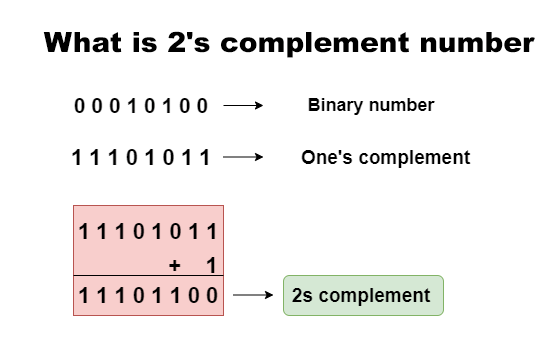Introduction
The 2’s complement number is a mathematical operation used to represent negative numbers in binary form. It is a method of encoding signed integers in binary form, in which the most significant bit (MSB) of the binary representation is used as a sign bit.
Characteristics
- In 2’s complement, the MSB of the binary representation is used as a sign bit.
- 2’s complement is a way of representing negative numbers in binary form.
- The range of values that can be represented using 2’s complement is from -2^(n-1) to 2^(n-1)-1, where n is the number of bits in the binary representation.
Construction
To construct the 2’s complement representation of a negative number, you first take the binary representation of the positive equivalent of the number. Then, you flip all the bits, and add 1 to the result. For example, to find the 2’s complement of -5, you first find the binary representation of 5, which is 0101. Then, you flip all the bits, which gives you 1010, and add 1 to get 1011.
Working
2’s complement is used in computer systems and digital circuits to represent both positive and negative values. To add two numbers in 2’s complement form, you simply add them together as if they were unsigned binary numbers. If the result is larger than the largest number that can be represented in the given number of bits, then the result is truncated to fit within the given range. To subtract one number from another in 2’s complement form, you simply add the negative of the second number to the first number.
Procedure
To convert a decimal number to its 2’s complement representation, you must first determine the number of bits required to represent the number. Then, you convert the magnitude of the number to binary form and apply the 2’s complement operation to the result. To convert a 2’s complement representation back to decimal form, you must first determine whether the number is positive or negative by examining the sign bit. If the sign bit is 1, then the number is negative, and you must apply the 2’s complement operation to the remaining bits. If the sign bit is 0, then the number is positive, and you can simply convert the remaining bits to decimal form.
Rules
- In 2’s complement, the MSB of the binary representation is used as a sign bit.
- To find the 2’s complement of a negative number, you first find the binary representation of its positive equivalent, flip all the bits, and add 1 to the result.
- To add two numbers in 2’s complement form, you simply add them together as if they were unsigned binary numbers.
- To subtract one number from another in 2’s complement form, you simply add the negative of the second number to the first number.
Formula
To convert a decimal number to its 2’s complement representation, you can use the following formula:
- If the number is positive, convert the magnitude of the number to binary form.
- If the number is negative, find the 2’s complement of its positive equivalent.
To convert a 2’s complement representation back to decimal form, you can use the following formula:
- If the sign bit is 0, convert the remaining bits to decimal form.
- If the sign bit is 1, find the 2’s complement of the remaining bits and add a negative sign to the result.
Need
The 2’s complement number system is used in digital systems to represent signed integers. There are several needs for 2’s complement numbers, including:
- Representation of negative numbers: In digital systems, it is necessary to represent negative numbers. The two’s complement number system provides a simple and efficient way to represent negative integers.
- Addition and subtraction: The two’s complement number system simplifies the addition and subtraction of signed integers. The arithmetic operations can be performed using the same hardware as for unsigned integers, simplifying the design of digital systems.
- Compatibility: The two’s complement number system is widely used in digital systems, making it compatible with many devices and software programs.
- Efficiency: The two’s complement number system allows for efficient hardware implementation of arithmetic operations, making it suitable for use in high-performance digital systems.
- Symmetric range: The range of integers that can be represented in the two’s complement number system is symmetric, which simplifies calculations involving negative numbers.
- Overflow detection: The two’s complement number system provides a simple way to detect integer overflow, which can occur during arithmetic operations.
Applications
- Computer science and programming
- Digital electronics and telecommunications
- Image processing and analysis
- Financial modeling and analysis

